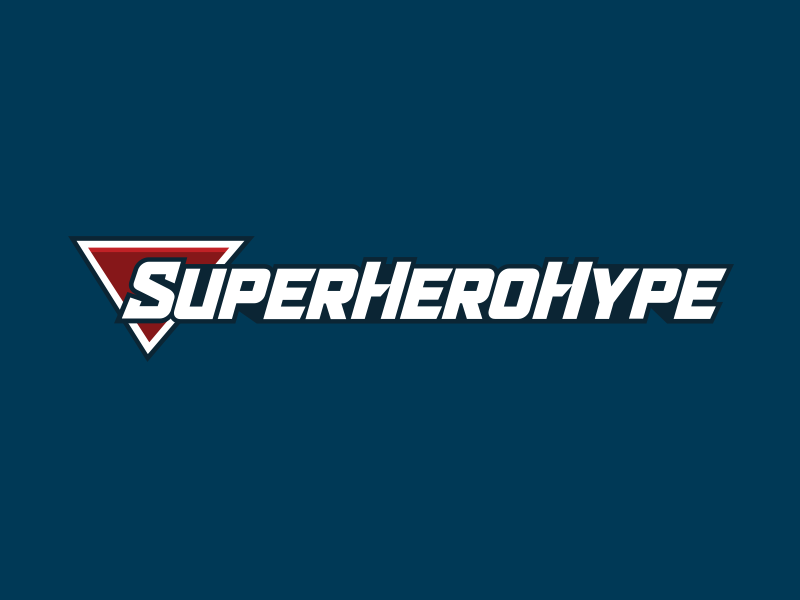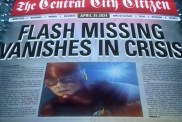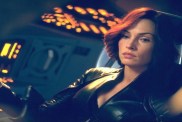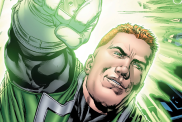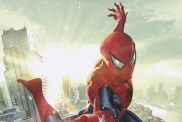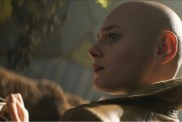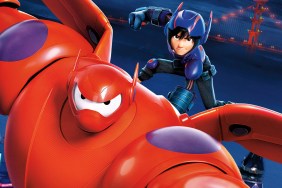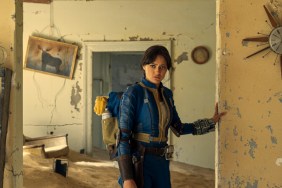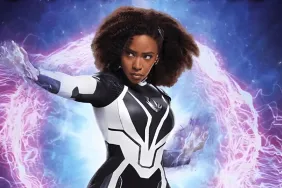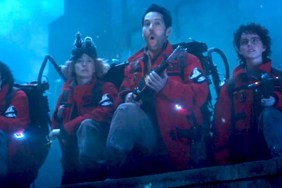
Earlier this week, ComingSoon.net/Superhero Hype! flew down to Albuquerque, New Mexico to visit the green screen sets of Will Eisner’s The Spirit, which director Frank Miller has been shooting at the city’s new facilities, Albuquerque (ABQ) Studios. It brings to life Will Eisner’s classic comic book character Denny Colt, a police officer in Central City who was killed in action, but then returned as The Spirit, a masked crimefighter who has a way of attracting the ladies—and not only the nice ones—but who’s thwarted at every turn by the evil mastermind The Octopus.
The film is being made much like Miller’s Sin City and Zack Snyder’s adaptation of Miller’s 300 with actors doing all of their performances in front of a green screen and all the backgrounds and environments created using the latest computer graphics. This was ComingSoon.net’s second visit to an all green screen set after spending some time on the set of 300 two years ago, and while one might not expect there to not be a lot to write about when a movie is being made with no actual sets, in fact, there’s still stuff to see, since it’s an interesting process that requires a lot of clever workarounds for things that tend to be easy when using practical sets, such as how actors interact with objects within their environment, or lack thereof.
The production had taken up two of the larger soundstages at the brand new Albuquerque Studios facility, where security was extremely tight. Cameras and audio recording were verboten, and anyone who wanted to visit the stages needed to turn in their personal ID in order to get a special badge with an image of what looked like a Frank Miller drawn full body portrait of The Spirit. There wasn’t any question that it was worth losing or forgetting your driver’s license or passport there, if it meant a chance to watch a master like Miller at work. The Spirit is the first production to use the complex’s two newest stages and they were on Day 27 of a shoot that would be going through December 14.
After a quick meal, our tour consisted mainly of visiting those two main soundstages that were being used simultaneously, each of them serving a specific purpose and function. Stage 7 was being used almost exclusively for stuntwork and the neighboring Stage 8 was used for shooting the key scenes with the primary characters. Stage 8 had been split in half with one half completely covered with green screen material, including the floor, which had cardboard down so we wouldn’t have to remove our shoes as the sign on the outer door warned; the other half was surrounded by black drapes, which apparently is another way of creating the backgrounds, maybe in the scenes that require more of the noirish look that Miller made famous in Sin City. When we arrived, there was a truck on the green screen side of the stage emblazoned with the words “Ditko’s Speedy Delivery”, obviously a nod to Steve Ditko, another one of Miller’s inspirations and the co-creator of a certain superhero some of our readers might be familiar with.
Stage 7 seemed larger maybe because it wasn’t split in half, but the green screen went up over 40 feet and there were black drapes visible that could be pulled over the green screen in order to do larger scenes requiring the black background. There were a number of large set pieces on this stage, objects in the environment that would require direct contact with the actors. The first one was a two-story fire escape very much like one we might see in Eisner’s comics, not too far away was a medium-sized brick wall, and then on the other side of the stage was a larger set piece referred to as the “grassy knoll.” Instead of being a bright green patch of land, this looked like the kind of dead area of foliage you sometimes find in big city slums under overpasses with the grass being overgrown and brown from lack of water with scattered debris and objects, like a mangled bike, strewn about it. Again, it was very much like something we would see in Eisner’s view of Central City. (The other stage was even referred to as “The Projects” which made sense since Central City was very much a darker version of New York’s Lower East Side where Eisner happened to live.)

We walked around a bit surveying the three minimal set pieces and then spent 20 minutes talking to producer Deborah del Prete, who also produced Lexi Alexander’s Hooligans–ironically, Alexander is in Montreal making Lionsgate’s other superhero movie Punisher: War Zone–and she told us a bit about the origins of the project when she first met Batman executive producer Michael Uslan at Comic-Con and he asked if she’d be interested in producing a movie based on Will Eisner’s The Spirit. Even though the movie will be distributed by Lionsgate, it’s being produced entirely by del Prete’s Odd Lot Entertainment, so that Miller can make the movie he wants to make. Miller’s sensibilities tend to steer towards the R-Rated though Eisner’s work was considerably more wholesome, yet Del Prete didn’t say that they were “going for” any particular rating but would just let Frank make his movie and see where things lie. The key motto on the set was that this movie was very much going to be Frank Miller’s take on Will Eisner’s “The Spirit.” Any concerns about Miller making this movie without his Sin City partner in crime Robert Rodriguez probably should be dispelled, as he has a great team on this one, including cinematographer Bill Pope, who shot movies like “The Matrix” trilogy and the last two “Spider-Man” movies, so yeah, you can say that he has his action and effects chops all set. Many might be expecting a very dark movie due to Miller’s past work, but Del Prete has promised that the movie will be funny as well.
After speaking to her, we got to watch as Miller set-up a stunt on the fire escape where Gabriel Macht was hanging on from the top tier and swinging up with his feet, presumably to climb up there. Macht practiced the stunt a few times with some mysterious dust flying everywhere (presumably for effect) and at one point, Miller had to give him a bit of direction because Macht was smiling instead of “snarling” which is what Miller required. After shooting this stunt, Miller came over briefly to talk to us, fielding most of the journalists’ questions with short answers, deliberately giving very little detail away. (We’ll run both interviews sometime soon.)
To some, Gabriel Macht might not seem like the best visual match for Denny Colt, being that he’s known for his blonde hair, but it’s been dyed jet black, and unlike Eisner’s comics where the Spirit’s coat is seemingly colored blue, Macht wears a solid black coat, pants and hat with a white shirt and a bright red tie, which really stands out against the black outfit. Later, we’d get to meet with him for a few minutes and up close, you can see that the costume is ripped in places, at least at the end of the movie after fighting with The Octopus, giving it even more of the look of Eisner’s raggedy take on the character, who rarely looked as pristine as Macht. We could also see that his mask seemed to be painted on his face, although it was just wafer thin and attached to his face with spirit gum. Macht really looked great and any diehard Spirit fan should be happy with this unconventional choice. Macht considers the role one of the greatest opportunities as an actor and he felt that it was his “absurdity” that came across in his first meeting with Miller that got him the part since it lent itself to the character’s sense of humor.
As mentioned above, The Spirit’s main enemy in the movie is Samuel L. Jackson as The Octopus, a mysterious behind-the-scenes crime figure seen in the comic books merely as a single gloved hand, but Miller knew that if he used the character we’d have to see his face and Jackson was Miller’s first and only choice. Later, we’d have a chance to see Jackson and Macht in a fight sequence that happens late in the movie, which would give us a closer look at the Octopus’ costume, which is pretty freaking wild. From a distance, it looks almost like a fur pimp coat covered with images of intertwined octopus tentacles, but it’s actually heavy leather with a fur collar, and Jackson seemed to have a number of different variations of the black and white outfit, longer and shorter versions with seemingly different variations for different lighting circumstances. Jackson’s head was shaved bald as we’ve seen him many times before, but he seemed to be wearing contacts that kept his eyes wide open, and he had black dots all over his face and heavy white make-up around his eyes, possibly to give him a freakier look like one of The Spirit’s classic rogues.

Jackson came over in between filming to shoot the sh*t and we got to see more details of this crazy-looking outfit once he took the jacket off. Underneath, he was wearing a tight-fit red tunic and a wide studded belt with his left arm covered up to the shoulder by a black glove and his other hand covered by a smaller white glove. Between that and the jacket, the outfit made him look almost like if the Bad-era Michael Jackson shaved his head and became a pimp. (::shudder::) Still, Jackson knew how to sell the character, and one can expect that many enterprising fans will try to imitate the costume at Comic-Con once they see it.
We also got to look at the production board with some of Miller’s sketched-out storyboards and black and white still photos from the production including a few seductive pictures of Eva Mendes in heavy mascara as Sand Sarif and Scarlett Johanssen with glasses as Silken Floss, another classic Eisner femme fatale. Del Prete and Miller both hinted that there’d be lots of cameos by other Spirit characters, and we already know that Jaime King and Paz Vega (Spanglish) will be playing two of them.
There was also a photo of Macht in silhouette striking a pose similar to the teaser poster for the movie with his bright red tie off to the side as if blowing in the wind, creating a neat effect.
Sadly, our set visit and time spent with Miller and the actors was far shorter than we had hoped, nor did we get to see too much of the production or concept art besides what we saw on the board. We also weren’t given too clear an idea what the plot was about, except that it was by no means an origin story and that it mainly told the story of Sand Sarif, the Spirit’s great love who went bad. I’m sure that once Miller gets what he’s shooting into the computers and the computer guys start messing around with it, it will look just as cool as Sin City and 300.
At the time of this writing, Will Eisner’s The Spirit is scheduled for release by Lionsgate on January 16, 2009. Check back later soon for our interview with producer Deborah del Pete.
Source: Edward Douglas
